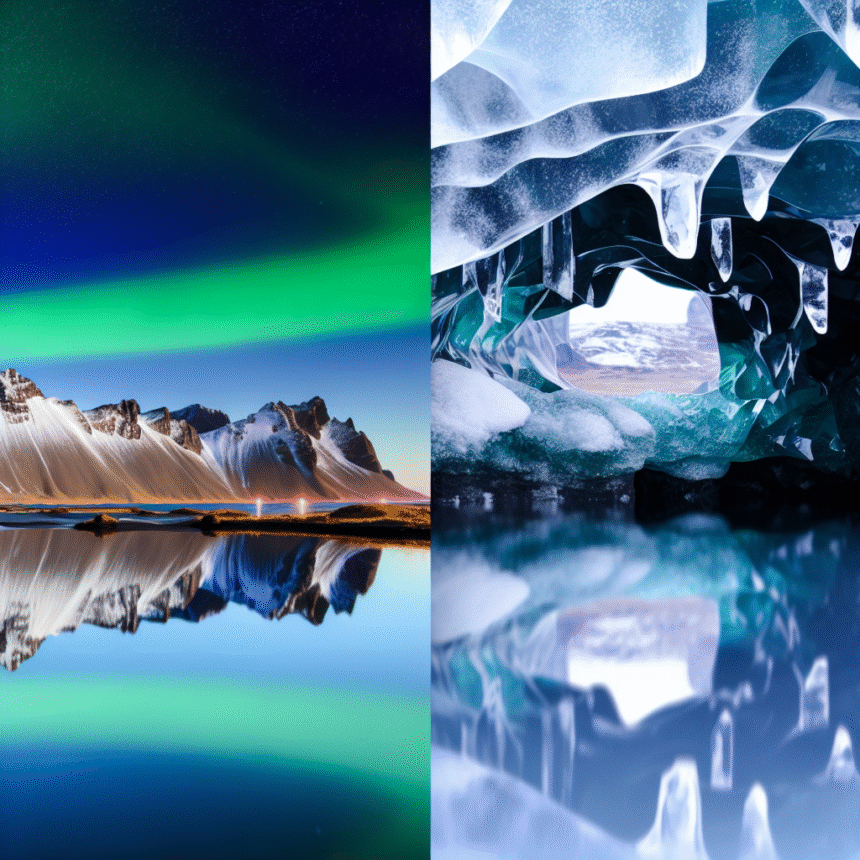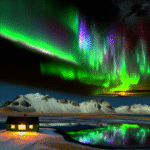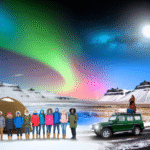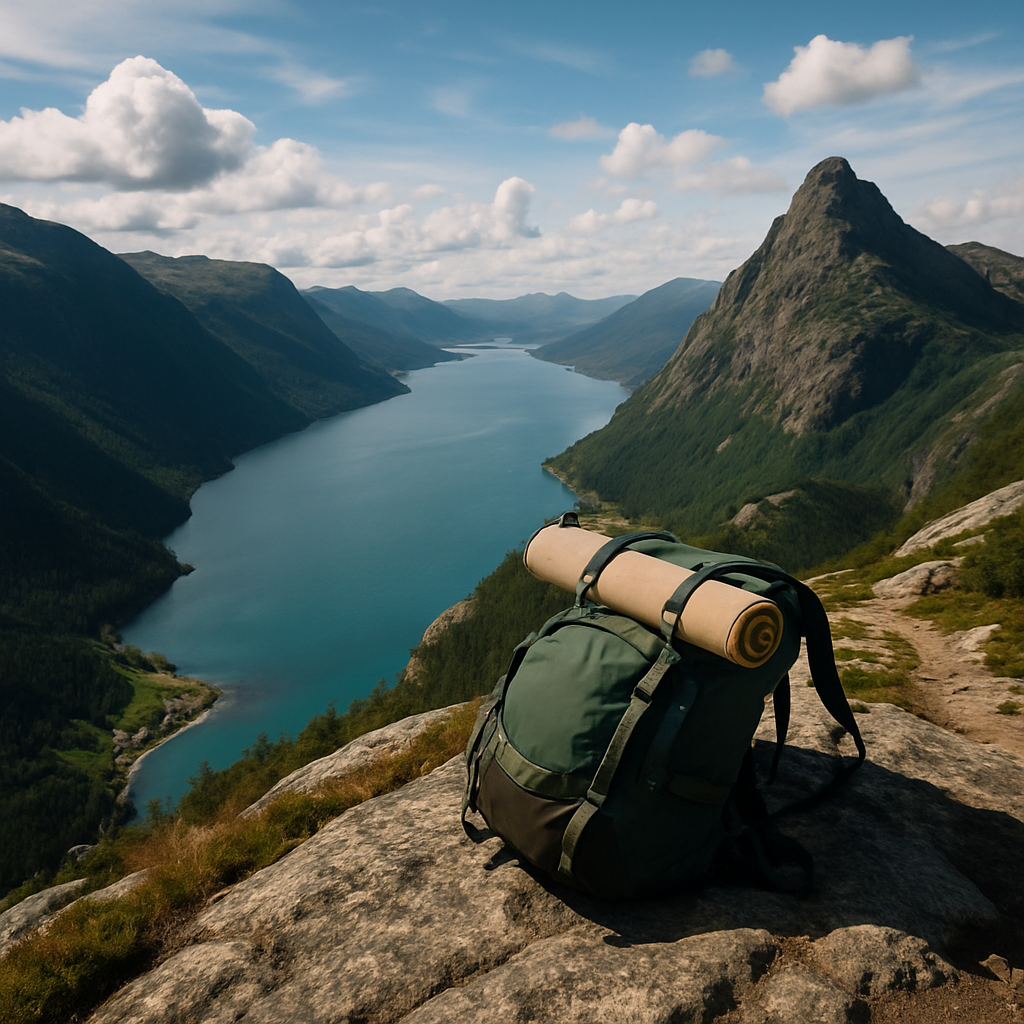There’s something enticingly defiant about visiting Iceland in November. Most people wait for summer’s endless daylight or winter’s Christmas sparkle, but you, dear traveller, are cleverer than that (and let me show you why).
November is the sweet spot for travel with quieter roads, cheaper prices, and the country at its most dramatically unpredictable (because, well, Iceland). It’s the month when the Northern Lights begin to take charge across the night sky, ice caves open for exploration, and cafés fill with the smell of pumpkin spiced something and damp woolly hats.
So, let explain what this curious month has to offer, and why you should be refreshing Skyscanner while reading.
Why Visit Iceland in November?
If you’re allergic to crowds and inflated prices, November is your antidote (cost efficient, not cheap). By the time you arrive, the summer crowds will have long vanished, leaving behind quiet roads, peaceful natural attractions, and villages and towns that feel that extra bit authentic.
The tour buses have mostly gone home, the Ring Road becomes your own private racetrack (within speed limits, of course), and you’ll finally get to see that wild, cinematic Iceland everyone raves about (or the guides that I write, at least) without someone in a bright yellow poncho ruining your photos.
And I’ll be honest, even campervan hire becomes an affordable luxury, and popular attractions like the Golden Circle are blissfully empty. Restaurants almost always have tables free without a reservation (maybe just not the michelin star one in Reykjavík), and you can linger at viewpoints without being rushed.
It’s also right in the midst of the Northern Lights season and the start some winter festivities, such as Hafnarfjörður Christmas market, early seasonal menus, and locals easing into hygge mode (a danish expression that Icelanders would probably reword as simple, cosy). Yes, the days are shorter, but that just means longer, cosier (you’re getting it) nights and more time to chase the aurora rather than pretending to enjoy daylight hikes in freezing winds (those happy Instagram reel are for sure fake).
What’s the Weather Really Like in November?
In short: moody, theatrical, and entirely unpredictable. Expect a full range of weather, no matter whenever you come to visit Iceland, from soft, misty drizzle and calm golden mornings to sudden blizzards that force you to question every life choice up to that point (hint: it was probably Skyscanner). Average temperatures sit between -1°C and 4°C, but with Iceland’s infamous wind chill, it can often feel much colder.
Daylight becomes a precious commodity this time of year. The sun doesn’t rise until around 9:30am and bids an Irish goodbye by about 4pm, casting the landscape in long, lingering twilight that photographers adore. Even at midday, the sun hangs low, giving everything that magical soft light that makes your campervan pictures look more cinematic than any other time of year.
Rain and snow can happen on the same day, and sometimes within the same hour (or 10 minute spell). Roads can glisten one moment and freeze the next, and coastal winds have been known to give random aggressive nudges here and there. But that’s part of Iceland’s charm: the weather writes its own adventure story (just sometimes that story is a bit annoying).
To stay comfortable, pack layers like an onion with trust issues. Thermal base layers, fleece, and waterproof outer shells are essential, and for footwear, focus on practical over fashionable such as reliable waterproof boots, not dainty trainers that like to get soggy. Also, don’t forget a hat, gloves, and maybe a spare set of socks for when your first pair inevitably loses the battle on a wonder, hike, or just a sneaky puddle.
It’s also wise to prepare your travel plans with flexibly in mind. After all, the weather can close mountain passes or delay a planned crater stop (sometimes it has even blown the waters of Seljalandsfoss upwards), but that’s where the freedom of a campervan shines, you simply reroute to somewhere equally stunning.
For real-time road and weather updates, always check SafeTravel.is before setting off, and follow the Icelandic Road Administration for up-to-date driving conditions. Stay alert, stay adaptable, and embrace the chaos, because Iceland is the expert in delivering the best and also, wildest, kind of surprises (spoiler: we have volcanoes).
Driving Around Iceland in November
November is when the real adventure begins, and when your driving skills meet their match. The Ring Road is usually easily accessible, offering breathtaking views of glaciers, plenty of volcanic terrain, canyons, craters, black sand beaches (you get the drift). However, remote areas like the Westfjords and central highlands are often snowbound and best left for summer (the Icelandic Highlands are completely closed in winter).
Stick to the south and west coasts for the most reliable conditions: the roads are well maintained, services are open, and you’re never far from a hot coffee or a hot spring (not a great combo at the same time, mind). South Iceland, from Reykjavík to Jökulsárlón, remains particularly popular for November road trips thanks to its mix of waterfalls, geothermal areas, and easy access to the Golden Circle.
Always rent a winter-ready campervan with studded tyres, snow brushes, ice scrapers, and a heater capable of keeping the Arctic chill at bay (ahem, we have a winter kit to cover just this). We specialise in winter and summer campervans alike, built for Iceland’s moody temperament: proper insulation, efficient heaters, and 24-hour roadside support if the weather decides to pull a fast one. You’ll also get an orientation on road safety and camper functions, so you won’t find yourself wondering why the windscreen fogs up faster than a pub mirror.
Driving in Iceland in November isn’t dangerous if you respect the conditions and plan sensibly. Always check the daily road reports, keep an eye on Vedur.is for storm warnings, and don’t drive during high wind advisories (and any serious weather warnings, come to think of it). A campervan gives you flexibility, and if the weather turns, simply park somewhere with a great view and wait it out with a cup of something warm.
Remember: speed limits exist for a reason. Ice patches and sudden gusts can turn a gentle bend into a heart-racing slide if you’re careless (and drive like my dad). Maintain safe distances, drive with headlights on at all times, and be careful getting in an out on particularly blustery days.
Respect the rules, use common sense, and you’ll find that November driving in Iceland is one of the most exhilarating ways to explore the country. It will definitely be memorable.
The Magic of Northern Lights Season
Ah yes, the main event for many of you. The shimmering and ever sought after Northern Lights, known also as the Aurora Borealis (latin for ‘northern dawn’). November is prime time for these celestial performances, with long, dark nights and crisp, clear air offering ideal viewing conditions. During this month, the skies are dark enough for hours on end, and the solar activity that fuels the lights is often at its liveliest (if you’re lucky).
The phenomenon itself is caused by charged particles from the sun colliding with Earth’s magnetic field to quote Professor Brian Cox. Although, when you’re standing beneath a glowing green ribbon dancing across the heavens, science tends to take a back seat to sheer awe, neckaches, and frantically testing camera settings. The colours vary from pale green to deep purples and occasionally streaks of red and blue.
For the best chance of seeing the aurora, base yourself far from city lights. Þingvellir National Park is a classic choice, offering wide open vistas and reflections over the tectonic pool at Silfra. Along the south coast near Vík, you can watch the aurora ripple above black sand beaches and th famous Reynisdrangar sea stacks. The Snæfellsnes Peninsula and the shores around Borgarfjörður also make excellent vantage points, while a campervan parked beside a quiet fjord might just become your private front-row seat to the universe (we’d love to see your snaps with a Happy Campers campervan in the foreground).
Before you head out, always check the aurora forecast on or download an Aurora app. Look for clear skies and hope for high activity levels (a KP index of 3 or higher is very promising in Iceland). Dress warmly with multiple layers, insulated boots, and a hot drink should do the trick. Also, bring a sturdy tripod if you’re planning to photograph the lights. Long exposures work best, and patience is essential: the lights can appear suddenly, vanish, and then explode into colour when you least expect it.
If clouds roll in (they are the worst nemesis for Aurora enthusiasts like me), don’t despair. Hop in your campervan and drive to clearer skies (if possible), which is one of the many reasons campervan travel is perfect for aurora hunting. The freedom to move means you can chase breaks in the weather instead of staring glumly at the clouds. And when the sky finally ignites, you’ll thank me and forget the hassle of the trek (it’s called a hunt for a reason, guys!)
Exploring Iceland’s Ice Caves and Glaciers
By November, the ice caves will all be open to visit, revealing some of Iceland’s most secret inner natural wonders. These shimmering blue caverns are mostly carved deep within the Vatnajökull Glacier (Europe’s largest) where centuries of compressed ice refract the light into crazy shades of sapphire, turquoise, and silver. Stepping inside one is like walking into a frozen cathedral sculpted by nature itself (or a very large blue fridge).
Each year, the caves are completely new. Melting and freezing cycles reshape them annually, so no two seasons are ever the same. Some are small tunnels that barely fit a person, while others soar high enough to make you feel like you’ve stumbled into Superman’s Fortress of Solitude (guess what I watched at the weekend). Guides spend early autumn scouting and securing safe access routes, making November the a very reliable month for exploration.
However, you can only explore with a certified guide, and for good reason. These caves are living, shifting structures, formed by meltwater rivers under massive ice sheets. Without an expert, venturing inside is both dangerous and daft (unless you fancy being permanently preserved in a glacier). Tours typically depart from Skaftafell and Jökulsárlón Glacier Lagoon, both of which are accessible by campervan if you drive carefully and plan your fuel stops.
On the tours, you’ll wear crampons and a helmet, crunch across eons of ancient compressed ice, and follow your guide through winding tunnels that echo with the sound of dripping meltwater (sometimes even a small and temporary waterfall). The air is crisp and eerily silent, and when the guide switches off the torch, the cave glows faintly from the natural light filtering through metres of ancient ice, which is something you’ll want to train up on a DSLR camera for.
Expect the experience to be cold, slippery, and utterly unforgettable. Bring waterproof gloves, thick socks, and a good camera. For the ultimate adventure, combine your cave exploration with a nearby glacier hike or a night camping in your van under the stars. After all, there are few places on Earth where you can go from frozen tunnels to frozen summits within a single afternoon.
Top Things to Do in Iceland in November
November in Iceland is undoubtedly a playground for adventure seekers and chill-chasers alike. This is the time to blend classic winter activities with hidden gems that reveal Iceland’s true character once the crowds disappear.
I recommend you spend your days exploring geothermal hot springs, titanous waterfalls, the odd lava cave, and volcanic craters, all along the snow-dusted landscapes. Each region offers its own kind of winter magic: dramatic coastlines in the south, steaming geothermal valleys near Hveragerði, and glacier walks in Vatnajökull National Park.
Yet it’s not all about braving the cold. November is also the month for indulging in Iceland’s cosy side, by experiencing some snug coffee houses where locals sip strong brews under fairy lights, and wandering through small towns that glow with warmth and welcome. From Reykjavík’s lively café culture to the rustic charm of Vík or Akureyri, it’s a season that encourages slowing down, layering up, and finding comfort in Iceland’s quirks and quiet corners (adventure, frost, and warmth, all in your rolling camper).
Chase Frozen Waterfalls and Steaming Landscapes
Waterfalls like Gullfoss, Seljalandsfoss, and Skógafoss take on an entirely new personality in November. They thunder through icy air, half-frozen in delicate veils of ice and mist, surrounded by snow-dusted cliffs. Gullfoss often glimmers with frozen spray that forms glassy sculptures along its edges, while Seljalandsfoss creates icy curtains you can peek behind if the path isn’t too slippery (November may be touch and go if I’m honest). Skógafoss, meanwhile, is magnificent in winter light, but eerily loud and hidden if you tread near it at night time (someone must have forgot to switch it off).
Take your time at each waterfall; you’ll likely have them almost to yourself at times. Bring crampons if the trails are icy (you can usually buy a pair cheap in a Bónus supermarket), and don’t forget a waterproof layer, as the wind has a way of sending mist straight at your camera lens. If you continue east, you can catch glimpses of smaller, lesser-known cascades hidden along the road that only appear after rainfall or thaw (but don’t miss the lesser-known sister falls of Skógafoss, Kvernusfoss, which is much better in my opinion).
To balance the chill, head to the famous Reykjadalur hot springs a short hike from Hveragerði. Here you can soak in a natural stream surrounded by snow, which is most definitely as epic as it sounds. Just be careful on the hike if there is ice and snow on the ground, as you may take a tumble or two (still worth it).
Soak in Iceland’s Hot Springs
There’s nothing more satisfying than stripping down to your swimsuit in sub-zero temperatures and sinking into a natural hot pool while snowflakes melt on your shoulders (just the first part you need to be a little brave with). Hot springs are part of Icelandic life, a centuries-old tradition that combines relaxation, socialising, and geothermal wonder in one steamy package. Whether you choose the highly popular Blue Lagoon, with its milky-blue silica waters and lava-field backdrop, or the newer (and better) Sky Lagoon, where infinity pools merge seamlessly with the sea, you’ll find yourself melting into complete serenity (you can get a beer in both, so Skál!)
But beyond the famous lagoons lie dozens of wild geothermal pools that promise a more intimate experience. For instance, Hrunalaug, a rustic stone pool tucked beside an old sheep shed near Flúdir, offers one of the most authentic dips in Iceland which is equal parts quiet, humble, and soul-soothing (not bad at all).
Each soak feels different: some pools bubble gently, others hiss and steam under a crust of frost. Sitting in them under a dark November sky, with the Northern Lights flickering faintly above, is one of those moments that make the cold worth it (even better if you and your partner have some good chat). Just remember to respect the nature. Keep to marked paths, and always leave the pools as pristine as you found them (take any trash with you as I’m sure David Attenborough would agree).
Explore the Golden Circle Without the Crowds
In summer, Thingvellir, Geysir, and Gullfoss heave with tourists, tour buses, and probably everyones rleatives as well. But in November, these icons return to their natural state of quiet, cold, and spectacularly untamed.
Frost glitters on the lava fields at Þingvellir, the rift between continents dusted with snow, while steam drifts lazily from the hot springs around Geysir (especially Strokkur that loves the most attention, spouting off every 5-8 mins) as if the earth itself were exhaling. Gullfoss, often half-frozen, is at its most dramatic this time of year, with icy spray catching the pale sunlight and forming crystalline rainbows above the canyon (plus it’s super snowy and that’s always beautiful to behold).
The Golden Circle route can easily be driven in a single relatively chilled day, even in November, with fewer vehicles and far more peace. Take your time to enjoy every stop: walk the rift valley trails at Thingvellir, warm your hands with a coffee at the Geysir visitor centre before watching Strokkur erupt against a backdrop of snow, and stand at Gullfoss listening to the roar of water under a halo of mist and frost (if you have the time, join a snowmobiling tour to Langjökull too).
Discover Iceland’s Quirky Winter Towns
Small towns like Vík, Hella, and Akureyri take on a cosy magic in November that’s hard to resist. Fairy lights begin to twinkle along quiet street in house windows, geothermal steam curls from backyard hot tubs, and the smell of fresh bread or freshly baked goodies often pours out café doors that feel like your nan’s living room (if your nan happened to run a boutique roastery).
Vík, perched along Iceland’s dramatic south coast, is an ideal stopover for campervan travellers exploring between waterfalls, ice caves, glaciers, craters (the list goes on). Its black sand beaches and towering sea stacks take on an eerie beauty under low winter light, and the town itself offers a warm welcome with its small restaurants and friendly locals (try the black crust pizzas).
Hella, further west, is a gateway to rural charm. It’s a quiet agricultural hub where you can mingle with locals at the swimming pool, browse tiny bakeries, or soak under the stars with plenty of peace and quiet.
Up north, Akureyri (often dubbed Iceland’s “second city”) transforms into a true winter wonderland. Sitting at the base of Eyjafjörður fjord and surrounded by snow-covered hills, vibrant street art peeking through frost, and cafés that serve some of the best hot chocolate in the country, it’s a wonderful place to spend some time in the North of Iceland.
Visiting these towns in November gives you a genuine glimpse of Icelandic life away from the tourist rush. The locals tend to slow down, communities prepare for the festive season (we get Christmassy early because of the needless darkness), and travellers who linger find more authentic stories at every stop.
Warm Up with Icelandic Food and Culture
November is comfort food season in Iceland (not fat camp for beach season). It’s a time when hearty dishes, rich aromas, and the warmth of local culture become as important as the landscapes outside.
Traditional Icelandic comfort food is designed to fend off the chill, so you’ll find steaming bowls of kjötsúpa (lamb soup) thick with root vegetables, creamy fish stew, and endless variations of rye bread served still warm from nature’s geothermal ovens. For those feeling adventurous, a brave nibble of fermented shark (hákarl) is a rite of passage (you’ll get a few extra hairs on your chest that day), although it’s more of a story to tell than a culinary highlight, but undeniably part of Icelandic tradition.
Hot chocolate, meanwhile, is a national obsession. Cafés across the country whip it up thick and decadent, piled with cream or toasted marshmallows, and paired with pastries that could convert even the most disciplined traveller out of their keto regime. Reykjavík’s coffee culture truly comes into its own in November, with locals retreating into candlelit cafés to read, chat, or simply people-watch while the wind howls outside (even regularly late into the evening…because a lot of the cafes also serve beer and wine).
Beyond the plate, Icelandic culture in November feels especially cosy and communal. Live music spills from bars in Reykjavík’s downtown, small theatres host seasonal plays, and museums offer warmth and stories in equal measure.
Don’t miss a dip at Sundhöll Reykjavíkur, the city’s historic swimming pool, where locals soak and gossip in steaming outdoor baths. There’s no better way to defrost after a cold day exploring than to join in one of Iceland’s most beloved social rituals (and pretend you understand every word).
What to Pack for a November Iceland Trip
Layers, layers, and more layers (and then some extra, oh you can guess it), because in Iceland, dressing well means dressing smart. Start with a thermal base layer to trap heat, add a fleece or wool mid-layer for insulation, and finish with a waterproof and windproof outer shell. The trick is versatility (substance over style).
Don’t forget the accessories that make all the difference, such as a woolyl hat that covers your ears, insulated gloves, and proper waterproof walking boots with good traction (not the cheap ones on Amazon that look like they genuinely might melt in the sun). Leave the trendy white trainers for your next city break; Iceland’s terrain will eat them for breakfast. A buff or neck warmer is also handy for blocking wind and adding warmth when it’s properly blustery.
For practical gear, pack a torch or headlamp for those long, dark nights (also good for storytelling) as daylight is limited, and a little light goes a long way when cooking outside your campervan or hiking back from a viewpoint. Bring a power bank or two for your phone and camera, especially if you plan to chase the Northern Lights, as cold weather drains batteries faster than you’d expect.
Snacks are essential, too (can you tell that I’m writing this guide a little hungry?) Granola bars, dried fruit, or Icelandic chocolate for quick energy on the road is a good shout, and if you’re feeling brave and hate your tastebuds, try some of the traditional local liquorice (not for me). Supermarkets in smaller towns can have limited hours, so stocking up early in Reykjavík is wise.
Budget Travel: Why November is the Month to Save
This is Iceland’s off-season, which means deep discounts on flights, campervans, accommodation, and even tours, without losing any of the adventure that makes the island so special (who likes queuing anyway?) November sits in that magical lull between the expensive summer rush and the festive winter peak, so you can enjoy Iceland’s landscapes, experiences, and serenity at a fraction of the usual cost (more money to spend on food…yep, still hungry).
Flights from Europe and North America often drop significantly, which can sometimes be nearly half the price of high season. Campsites and fuel costs remain affordable, and even guided excursions (from lava cave tours to whale watching trips) tend to offer lower rates and smaller group sizes. It’s one of the cheapest times to visit without taking anything away from the experience itself.
Travelling by campervan in November also helps stretch your budget further. You combine accommodation and transport into one cosy, mobile home, with the freedom to cook simple meals in your camper’s kitchenette and wake up each morning in a new, breathtaking location which remains at your discretion on a daily basis. Many travellers find that eating out sparingly and making use of local supermarkets keeps costs low without missing out on comfort, and we have plenty of meal tips from our team Vanlife lovers.
And because Iceland’s weather can be fickle, travelling outside the summer season also means more flexibility to change plans without worrying about sold-out hotels or fully booked tours (you laugh in the face of change).
Our team regularly runs exclusive winter deals in November, offering excellent value on campers well-equipped for the cold. There, I’ve warned you. Don’t miss out (and tell the team I told you).
A Suggested 5-Day Iceland November Itinerary by Campervan
Day 1: Pick up your campervan in Reykjavík, get familiar with your beast, and head to the Golden Circle. Visit Þingvellir National Park, Geysir, Gullfoss Waterfall (maybe a cheeky lunch at Fríðheimar tomato greenhouse) before soaking your travel-weary bones in the geothermal pools of Flúdir’s Secret Lagoon.
Day 2: Drive south toward the waterfalls of Seljalandsfoss and Skógafoss, both dazzling in their half-frozen glory (I am going to assume that is a real term). Continue to the volcanic black sand beaches of Vík, where Reynisdrangar sea stacks trolls (long story) rise ghostlike from the powerful waters. Pop into a cosy café for hot soup and local bread before parking your camperan up for the night at the awesome Þakgil campsite (a big team favourite when asked).
Day 3: Venture east to Skaftafell in Vatnajökull National Park and book an ice cave tour (assuming I persuaded you earlier on in the guide). Spend the day exploring glacier tongues, blue caves, and the stark beauty of the south-east coast. End your day at Jökulsárlón Glacier Lagoon, where icebergs drift lazily towards the sea. Watch them glow under the pastel light of dusk with hopefully a very easy Northern Lights chase.
Day 4: Begin your return west with a leisurely drive back through South Iceland. Detour to the geothermal town of Hveragerði, where you can hike to the hot river in Reykjadalur Valley and treat yourself to a free of charge dip. Then enjoy a decent meal in one of Selfoss’s local restaurants and have a beer or two.
Day 5: Wrap up your adventure in Reykjavík. Explore the city’s vibrant street art, sample pastries at a local bakery, and visit the National Museum or Harpa Concert Hall (big cube fish scaled looking building, you can’t miss it). Finish your journey with a traditional dip at Sundhöll Reykjavíkur or one last treat at the Sky Lagoon before returning your camper for a final slumber. And if the skies are kind, squeeze in one final Northern Lights hunt, to round off the perfect farewell to your Icelandic road trip.
Final Thoughts: Cold Hands, Warm Hearts, and a Happy Campervan
November in Iceland isn’t about perfection. It’s about spontaneity, weather dramas, and steaming cups of something hot while you watch the wind whip over all the crazy nature this wild island has to offer (and there’s a lot).
It’s about fewer tourists, lower costs, and the raw thrill of having Iceland almost to yourself.
And the best way to experience it all is, of course, from your cosy Happy Campers campervan (it really is that awesome), where the heater hums, the view changes daily, and every storm becomes part of the adventure (you’ll struggle to sleep in the future without the rock of the Icelandic winds….ok, maybe not).
Back








